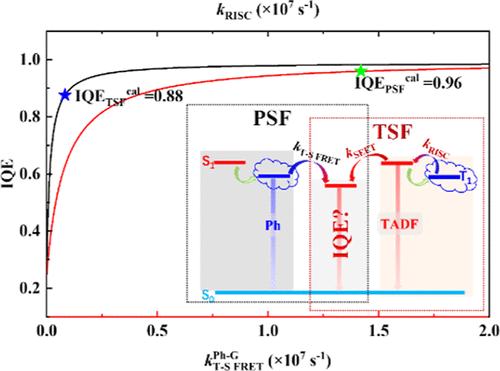OLED 发射层中的 TADF/磷光敏化荧光机制及其对设备性能的影响:理论见解
IF 3.2
3区 化学
Q2 CHEMISTRY, PHYSICAL
引用次数: 0
摘要
基于热激活延迟荧光或磷光敏化荧光[TADF-sensitized fluorescence (TSF) or phosphorescence-sensitized fluorescence (PSF)]的有机发光二极管(OLED)为具有高效率、更高色纯度、长寿命和低效率衰减的设备打开了大门。然而,迄今为止,人们对 TSF 和 PSF 系统中的光物理过程及其对器件性能的影响还不甚了解。本文结合分子动力学模拟和量子化学计算,深入研究了 TSF 和 PSF 系统的光物理过程。在所研究的 TSF [PCTF/TBRb] 体系和 PSF [Ir(ppy)2acac/TBRb] 体系中,详细分析了薄膜形态、电子特性和动力学过程。计算结果表明,[PCTF/TBRb]体系和[Ir(ppy)2acac/TBRb]体系分别表现出明显的TSF和PSF特征。两种敏化体系的区别在于敏化剂 T1 激子的利用过程。反向系统间交叉率(kRISCTADF)和三重子-小三重子佛尔斯特共振能量传递率(kT-SFRETPh-G)分别是影响 TSF 和 PSF 系统内部量子效率(IQE)的决定性因素。此外,我们还发现 kRISCTADF 对 TSF 系统 IQE 的影响要强于 kT-SFRETPh-G 对 PSF 系统 IQE 的影响。我们希望这些结果能促进人们深入了解 TSF 和 PSF 系统的机理及其对器件性能的影响,从而加速高效敏化有机发光二极管的开发。本文章由计算机程序翻译,如有差异,请以英文原文为准。

Mechanisms of TADF/Phosphorescence-Sensitized Fluorescence in OLED Emissive Layers and Their Impacts on Device Performances: A Theoretical Insight
Organic light-emitting diodes (OLEDs) based on thermally activated delayed fluorescence or phosphorescence-sensitized fluorescence [TADF-sensitized fluorescence (TSF) or phosphorescence-sensitized fluorescence (PSF)] open the door for devices with high efficiency, better color purity, long lifetime, and low-efficiency roll-off. However, the photophysical processes and their impact on device performances in TSF and PSF systems are not clearly understood to date. In this work, the photophysical processes for the TSF and the PSF systems are in depth investigated by combining molecular dynamics simulation and quantum-chemistry calculations. In the studied TSF [PCTF/TBRb] system and the PSF [Ir(ppy)2acac/TBRb] system, the film morphologies, electronic properties, and kinetic processes are analyzed in detail. The calculated results indicate that the [PCTF/TBRb] system and the [Ir(ppy)2acac/TBRb] system exhibit obvious TSF and PSF features, respectively. The difference between the two sensitization systems is the utilization process of the T1 excitons of the sensitizers. The rates of reverse intersystem crossing (kRISCTADF) and the triplet-singlet Förster resonance energy transfer (kT-SFRETPh-G) are the decisive factors in the internal quantum efficiency (IQE) of the TSF and the PSF systems, respectively. Moreover, it can be found that the effect of kRISCTADF on the IQE in the TSF system is stronger than the effect of kT-SFRETPh-G on the IQE in the PSF system. We hope that these results will promote an in-depth understanding of the mechanisms of the TSF and the PSF systems and their impacts on device performances, accelerating the development of highly efficient sensitized OLEDs.
求助全文
通过发布文献求助,成功后即可免费获取论文全文。
去求助
来源期刊

The Journal of Physical Chemistry C
化学-材料科学:综合
CiteScore
6.50
自引率
8.10%
发文量
2047
审稿时长
1.8 months
期刊介绍:
The Journal of Physical Chemistry A/B/C is devoted to reporting new and original experimental and theoretical basic research of interest to physical chemists, biophysical chemists, and chemical physicists.
 求助内容:
求助内容: 应助结果提醒方式:
应助结果提醒方式:


